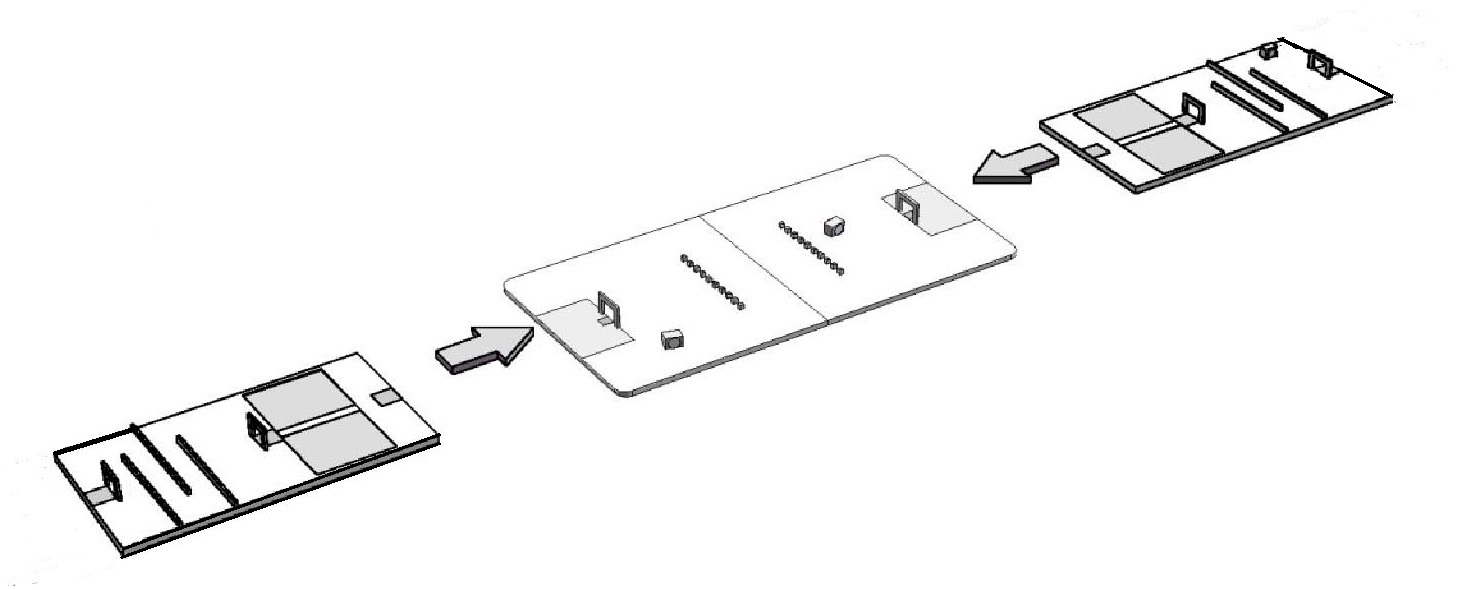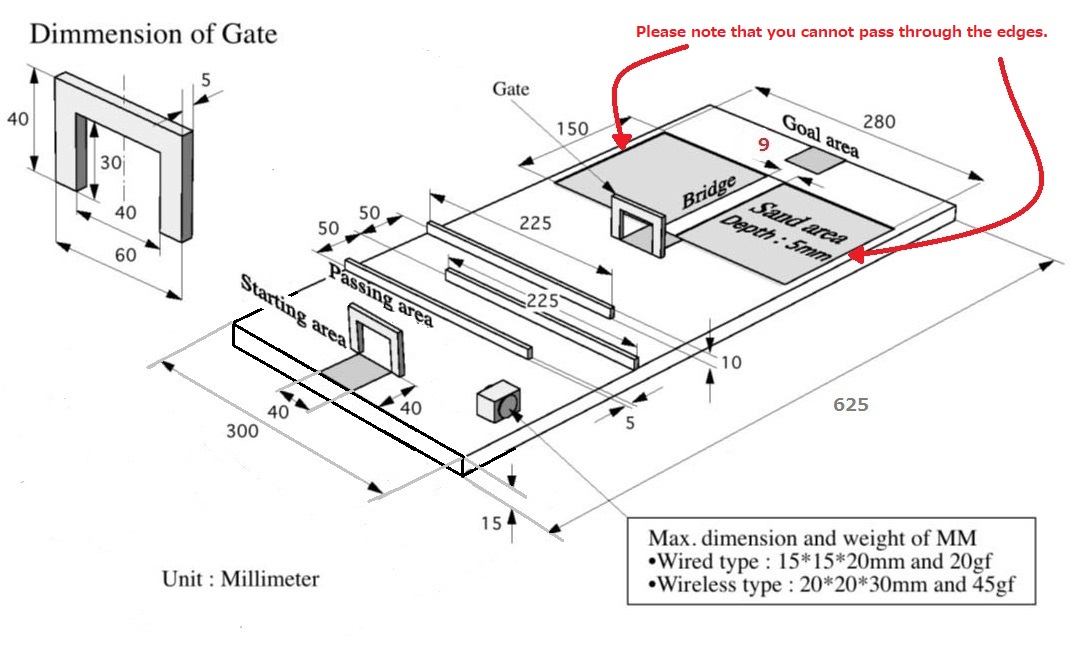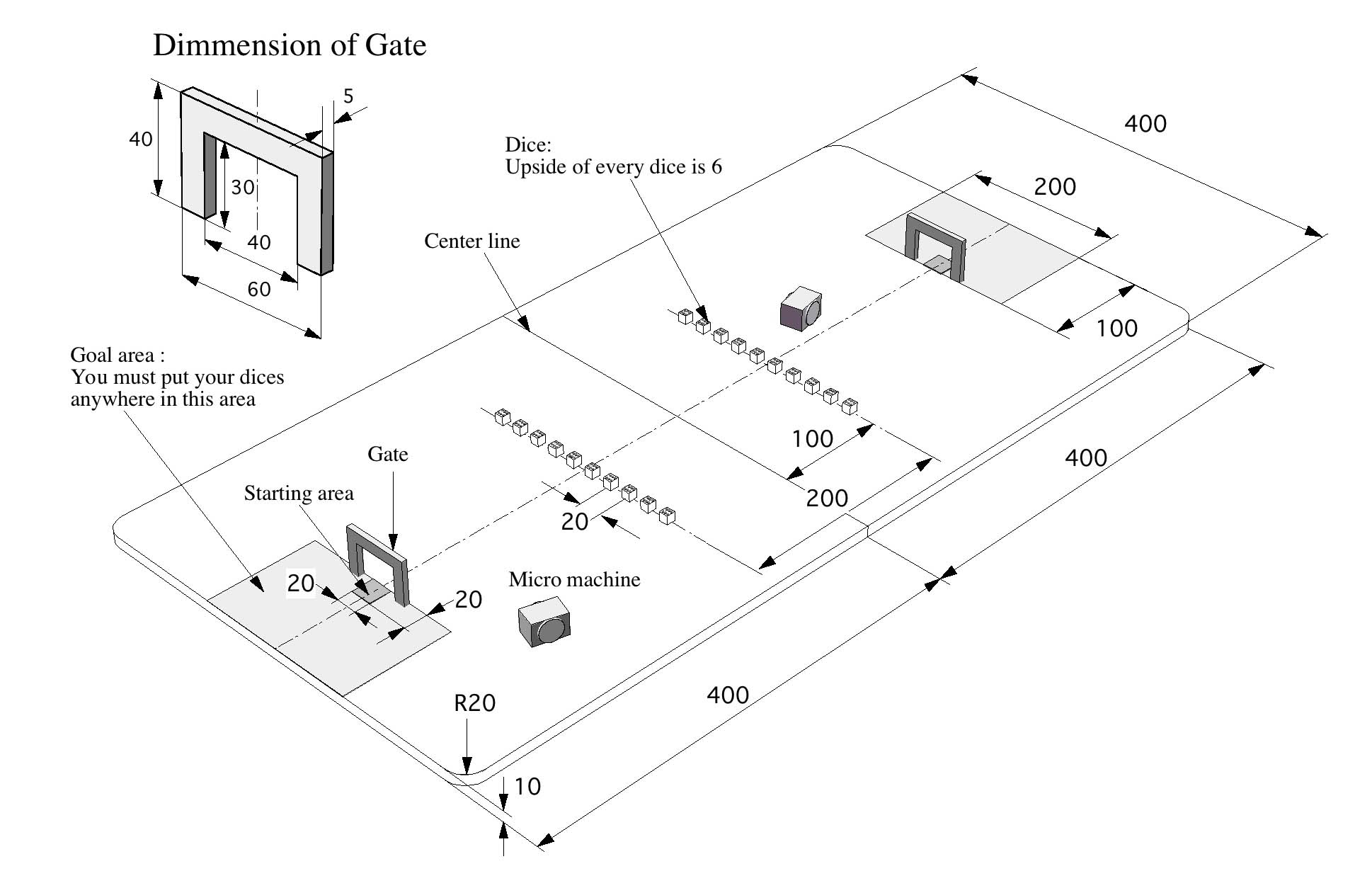Barrier-Climbing and Dice-Operating Micro Mechanism Competition
Feature
This competition aims at developing mechanisms, which can run effectively
on a plane board equipped with two kinds of obstacles, such as walls,sand, as well as the elemental and comprehensive technology.
And also, this competition aims at developing mechanisms which can both
move and perform specific operations. Machines carry dice (8mm squared,
weighing 0.7gf) to their own goals.
Important notice
This time, the width of the bridge in the Barrier-Climbing zone
sand area is narrowed down to 9mm.
Also, the cylindrical obstacle that was installed until last year is removed.
Details
Barrier-climbing and dice-operating micro-mechanism
competitions are combined as one competition (Fig. 1).
In addition, wired and wireless machines will compete against each other,
and only one winner will be determined in the competition. For wireless
machines, the restrictions on size and weight have been eased.
A gate is placed at each checkpoint to make the use of wireless machines
advantageous. The dimensions of the gates are shown in Fig. 2 and 3.
Wired machines must pass through three gates in the correct order from
the start to the goal and their cable must also pass through these gates with
the machine.
Therefore, wired machines are prohibited from having an initial cable
position in which their cable extends from the middle of the race field through
the gates in advance so that the cable no longer passes through the gates when
the machine passes through the gates.
Operators must not directly reposition the cable that has passed through
a gate by touching the cable. Neither wired nor wireless machines are allowed
to level out the sand area. Operators intentionally changing the conditions of
the cable and the sand will be disqualified.
To promote the miniaturization of machines, a special bridge of 9 mm
width will be placed over the sand area, making the use of a smaller machine
advantageous.

Fig. 1 Combined competition of barrier-climbing and dice-operating
micro-mechanism
(Click to view a larger picture.)
Barrier-climbing zone:
As shown in Fig. 2, machines should proceed from the starting area to the goal
area in the barrier climbing zone, in which three types of barrier are placed:
(1) walls, and (2) a sand area.
Machines must start from the starting area and pass through the gate (checkpoint)
before each barrier before reaching the goal as quickly as possible.
1. Walls: 10 mm high, 5 mm wide, and 225 mm long
2. Sand area: ordinary dry sand as seen in parks or in sandboxes in kindergartens,
5 mm deep
3. Bridge: 9 mm wide, 150 mm long, placed over the sand area.
The exact location of the bridge will not be disclosed until the start of the
competition.
4. Overall dimensions of barrier-climbing zone: 300 mm wide, 900 mm long,
surface covered with Kent Paper

Fig. 2 Barrier-climbing zone
(Click to view a larger picture.)
Dice-Operating zone:
You must start the dice-operating micro-mechanism game in the dice-operating
zone immediately after exiting the barrier climbing zone.
Operators may carry their machine from the goal of the barrier-climbing zone to
the starting area of the dice-operating zone. At this time, you may make minor
adjustments to your machine including the exchange of batteries and maintenance,
during which the timing is continued.
As shown in Fig. 3, cubic dice (8 mm side with a weight of 0.7 gf), with the
6-spot face as the top face, are lined up in the dice-operating zone.
Machines start from their starting area and enter the race field.
For wired machines, it is forbidden to remove the cable from the machine
and/or controller and continue the match without the cable passing through the
starting gate.
Each dice should be turned so that the 1-spot face (spot-1) is the top face and
carried to the contestantfs goal area within a limited time.
You may turn the dice to spot-1 in the goal area. The number of dice with
spot-1 in your goal area will represent your score.
Dice with other faces as the top face are not counted.
From this year, a new scoring system has been added as follows.
When a dice is stacked on another dice in your area, you will obtain four
points regardless of the number of spots on the top face of each dice.
Each pair of dice stacked vertically will give you four points.
Similarly, you will obtain eight points for each three dice stacked vertically
regardless of the number of spots on the top face of each dice.
Similarly, you will obtain
2n points when you stack n dice vertically (n2).
Note that dice can be stacked either inside or outside the goal area.
The surface of the dice-operating zone is made of Kent Paper and is level.

Fig. 3 Dice-Operating zone
(Click to view a larger picture.)
The total time of each match including the barrier-climbing and dice-operating
sections is three minutes. The winner is determined from the score in the
dice-operating section alone.
If both machines have no points or the same number of points, the machine that
first passed through the checkpoint furthest from the starting area in the
barrier-climbing zone will win the match.
Regulations:
(a) The size and weight limits are different for wired and wireless machines.
Wired machines, including all appendages (e.g., the hands and arms),
must fit in a box of size 15 mm ~ 15 mm ~ 20 mm at the start of the match.
However, the machines may have larger dimensions or be separated after the
start of the match.
Wireless machines must fit in a box of size 20 mm ~ 20 mm ~ 30 mm.
There are no regulations on the movement of the machines; they can run, crawl,
and jump.
(b) For wired machines, you may supply energy or send control signals through
lead wires or flexible tubes from an external device.
However, these wires and tubes must not be used to carry dice.
You must not directly push the main body of your machine by air pressure,
a rod, or other means.
(c) The referee calls two operators.
The timing will start when both operators have assembled.
Contestants should place their machines within their starting area when
the referee says gon your marks.h
The referee will say ggoh two seconds after confirming that both machines
are appropriately placed.
Minor adjustments can be made to the machines even after the referee says
ggo,h during which the timing is continued.
Machines equipped with a deformation mechanism are not allowed to start if
they exceed the size limit before the referee says ggo.h
Machines that cannot start within the match time will be disqualified.
(d) When using commercial radio apparatus, you must take great care to ensure
that the signals of your machine do not interfere with those of the opponentfs
machine.
Matches will not be stopped owing to the interference of radio signals.
Operators should pay close attention to signal interference, for example,
by keeping their controllers switched off except during their own match.
Operators must not intentionally disturb by jamming the radio signals of
their opponent will be disqualified.
(e) Your machine can enter the opponentfs area, after all the dice in your area
have been carried to your goal area and turned to the spot-1.
If your machine enters the opponentfs area by mistake before meeting these
requirements, you will be ordered to start over again from the starting area.
After your machine is qualified to enter the opponentfs area, you may use
the opponentfs dice in the opponentfs area to increase your own score.
However, no part of the machine (including the cable of wired machines) can
enter the opponentfs goal area.
(f) It is forbidden for machines to come into contact with the opponentfs dice
that have already been stacked.
If your machine (including the cable of wired machines) knocks down opponentfs
stacked dice, you must restore them to their original condition and carry your
machine back to the starting area.
(g) Under no circumstances are you allowed to interfere with the movement of the
opponentfs machine. During a scramble between two machines for control of
a dice, the movement of the machine in its own area is prioritized.
(h) In addition to the competition itself, a Concept Prize, a Technical Prize,
and an Artistic Prize will be awarded.
Sample dice can be sent to applicants on request.
Back
|